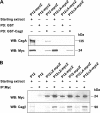The coupling protein Cagbeta and its interaction partner CagZ are required for type IV secretion of the Helicobacter pylori CagA protein
- PMID: 20876293
- PMCID: PMC2981317
- DOI: 10.1128/IAI.00796-10
The coupling protein Cagbeta and its interaction partner CagZ are required for type IV secretion of the Helicobacter pylori CagA protein
Abstract
Bacterial type IV secretion systems are macromolecule transporters with essential functions for horizontal gene transfer and for symbiotic and pathogenic interactions with eukaryotic host cells. Helicobacter pylori, the causative agent of type B gastritis, peptic ulcers, gastric adenocarcinoma, and mucosa-associated lymphoid tissue (MALT) lymphoma, uses the Cag type IV secretion system to inject its effector protein CagA into gastric cells. This protein translocation results in altered host cell gene expression profiles and cytoskeletal rearrangements, and it has been linked to cancer development. Interactions of CagA with host cell proteins have been studied in great detail, but little is known about the molecular details of CagA recognition as a type IV secretion substrate or of the translocation process. Apart from components of the secretion apparatus, we previously identified several CagA translocation factors that are either required for or support CagA translocation. To identify protein-protein interactions between these translocation factors, we used a yeast two-hybrid approach comprising all cag pathogenicity island genes. Among several other interactions involving translocation factors, we found a strong interaction between the coupling protein homologue Cagβ (HP0524) and the Cag-specific translocation factor CagZ (HP0526). We show that CagZ has a stabilizing effect on Cagβ, and we demonstrate protein-protein interactions between the cytoplasmic part of Cagβ and CagA and between CagZ and Cagβ, using immunoprecipitation and pull-down assays. Together, our data suggest that these interactions represent a substrate-translocation factor complex at the bacterial cytoplasmic membrane.
Figures






References
-
- Amieva, M. R., and E. M. El-Omar. 2008. Host-bacterial interactions in Helicobacter pylori infection. Gastroenterology 134:306-323. - PubMed
-
- Amor, J. C., J. Swails, X. Zhu, C. R. Roy, H. Nagai, A. Ingmundson, X. Cheng, and R. A. Kahn. 2005. The structure of RalF, an ADP-ribosylation factor guanine nucleotide exchange factor from Legionella pneumophila, reveals the presence of a cap over the active site. J. Biol. Chem. 280:1392-1400. - PubMed
-
- Andrzejewska, J., S. K. Lee, P. Olbermann, N. Lotzing, E. Katzowitsch, B. Linz, M. Achtman, C. I. Kado, S. Suerbaum, and C. Josenhans. 2006. Characterization of the pilin ortholog of the Helicobacter pylori type IV cag pathogenicity apparatus, a surface-associated protein expressed during infection. J. Bacteriol. 188:5865-5877. - PMC - PubMed
Publication types
MeSH terms
Substances
LinkOut - more resources
Full Text Sources

